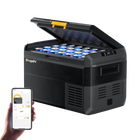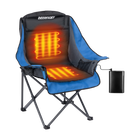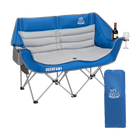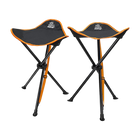Thin-film Solar Panels: What You Need to Know!
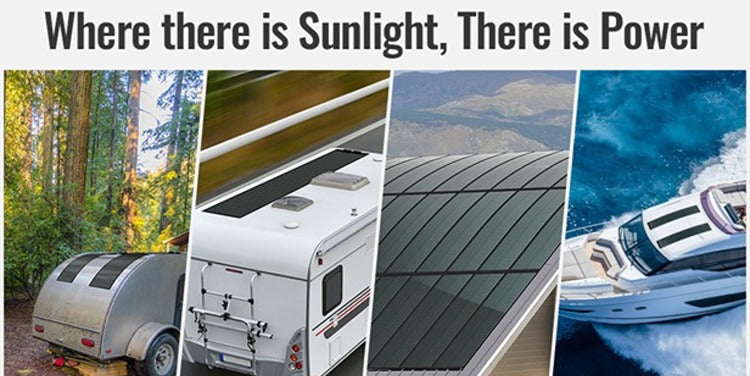
Although the traditional, bulky silicon solar panels that most people know and use. Actually, the thin-film solar panel is another excellent option with great promise. They are lighter and more convenient, and they can still work well even in weak light conditions, which is a make-up for the defect of rigid solar panels.
Thin-film solar panels, also known as flexible solar panels, are composed of one or more layers of light-absorbing thin-film material that generates electricity. You might be thinking: What? This sounds not reliable as the solid one. In fact, they are more reliable than you might think, perform well, and have a stable output in low-light conditions.
Read on and discover more about what thin-film solar panel is, how it benefits you, and more!
- What are Thin-film Solar Panels?
- How Thin-film Solar Cells Are Made?
- Types of Thin-film Solar Panels
- Features of Thin-film Solar Panels
- What are Thin Film Solar Panels Used for?
- Benefits of Thin-film Solar Panels
- How to Install Thin-film Solar Panels?
- Conclusion
- FAQs
What are Thin-film Solar Panels?
Thin-film solar panels are pretty thin with each layer of only 1 micron thick, they are even thinner than hair.
Like traditional monocrystalline or polycrystalline solar panels, thin-film solar panels can convert light energy into electricity through the photovoltaic effect. However, a thin-film solar cell is much more lightweight and flexible to install. Its surface is composed of many light-absorbing films that combine to form a film that is about 300-500 times thinner than standard silicon, which is the outstanding advantage of thin-film solar panels.
It is no exaggeration to say that thin-film solar panels are the lightest panels available today, with each cell consisting of three main components: the photovoltaic material, the conductive sheet, and the protective layer. In addition to the slim internal design, thin-film solar panels are also extremely durable, as we will expand on in the next article.
How Thin-film Solar Cells Are Made?
Thin-film solar panels are manufactured through a process that involves depositing one or more thin layers of photovoltaic (PV) material onto a supporting substrate. This substrate can be made of various materials such as plastic, glass, or metal. The production of thin-film solar panels typically consists of three main components:
Photovoltaic Material:
The photovoltaic material is the active layer responsible for converting sunlight into electricity. It is typically composed of various semiconductor materials, such as amorphous silicon (a-Si), cadmium telluride (CdTe), or copper indium gallium selenide (CIGS). Each of these materials has unique properties that affect the efficiency and performance of the thin-film solar panel.
Conductive Sheet:
The conductive sheet serves as the electrical contact for the thin-film solar panel. It enables the flow of electricity generated by the photovoltaic material. Commonly, transparent conductive oxide (TCO) layers made of materials like indium tin oxide (ITO) or fluorine-doped tin oxide (FTO) are used as the conductive sheet.
Protective Layer:
The protective layer safeguards the thin-film solar panel from external factors such as moisture, dust, and physical damage. It acts as a barrier, preventing the degradation of the photovoltaic material and ensuring the longevity and durability of the panel. Materials like glass or transparent polymers are often utilized as the protective layer.
The specific manufacturing process may vary depending on the type of thin-film technology employed, but the fundamental principle remains the same. Through precise deposition techniques and careful layering of materials, thin-film solar panels are created, offering a flexible and lightweight alternative to traditional crystalline silicon solar panels.
Types of Thin-film Solar Panels
They’re four common types of thin-film solar panels typically used in outdoor applications: copper gallium indium diselenide (CIGS), cadmium telluride (CdTe), amorphous silicon (a-Si), and gallium arsenide (GaAs) solar panels. Now, let’s take a look at these different thin-film solar panels one by one.
1. Copper indium gallium selenide (CIGS) solar panels
CIGS solar panel is versatile manufactured by various processes, and implemented in different forms. In addition, the CIGS solar panel is more appealing as a highly efficient alternative to large commercial solar modules. Some companies are using this for commercial use, which has proved to work well. BougeRV has also released CIGS solar panels for you to install easier and use more happier.
CIGS solar panels are not popular for conventional applications and are mainly used in space applications because of their low-temperature resistance and their excellent performance under low-intensity light conditions in space. The cost is relatively high compared to other technologies, currently priced at slightly more than $0.60/W, but future manufacturers promise to reduce the cost of these panels.
Although CIGS thin-film solar panels are not yet as popular in the market as CdTe panels, CIGS technology still accounts for 2.0% of the PV market share. This is still quite popular as thin-film solar technology, considering that thin-film solar modules hold only about 10% of the market share.
Composition of Copper Indium Gallium Selenide (CIGS) thin-film solar cell - Source: SOLAR ENERGY TECHNOLOGIES OFFICE
2. Cadmium telluride (CdTe) solar panels
CdTe is the second most common photovoltaic material after silicon, and CdTe cells can be manufactured using low-cost manufacturing processes. While this makes CdTe solar panels a cost-effective alternative, they are still not as efficient as silicon solar panels.
CdTe solar cells are fabricated using an absorber layer containing a p-n heterojunction that combines a p-doped CdTe layer with an n-doped CdS layer, which can also be made from magnesium zinc oxide (MZO). To deposit the material on the substrate, manufacturers use vapor-phase transport deposition or proximity sublimation techniques.

Composition of CdTe thin-film solar cells - Source: SOLAR ENERGY TECHNOLOGIES OFFICE
3. Amorphous silicon (a-Si) solar panels
Amorphous silicon (A-SI) is a kind of allotropic amorphous silicon, which is the perfect thin-film technology so far. Thin film silicon substitutes traditional wafer (or block) crystalline silicon. A-si is attractive as a solar cell material because it is an abundant, non-toxic material. It requires lower processing temperatures and is capable of scalable production on flexible, low-cost substrates that require little silicon.
Although a small amount of inexpensive material is required to manufacture amorphous silicon (a-Si), it is relatively expensive because the conductive glass for these panels is expensive and the process is slow, making the total cost of the panels set at $0.69/W. This technology currently accounts for 2.0% of the retail PV module market.
![]()
Schematic of amorphous silicon (a-Si) cell structure - Source: Inorganic photovoltaic cells: Operating principles, technologies, and efficiencies - review by Karzazi, Y., and Arbouch, I.
4. Gallium arsenide (GaAs) solar panels
Gallium arsenide (GaAs), an III-V direct bandgap semiconductor, is a very common material used in monocrystalline thin-film solar cells.GaAs solar cells have been among the highest-performing thin-film solar cells due to their superior thermal performance and high efficiency. As of 2019, single-crystal GaAs cells have the highest solar cell efficiency of all single-junction solar cells, with an efficiency of 29.1%.
Because GaAs PV cells are multi-junction III-V solar cells consisting of a hierarchical buffer layer, they can achieve high efficiencies of up to 39.2 percent, but manufacturing time, material costs, and high growth materials make them a less viable option for terrestrial applications. GaAs thin-film solar cells are rated at a record 29.1 percent efficiency.
The cost of these III-V thin-film solar cells ranges from $70/watt to $170/watt, but NREL says the price could be reduced to $0.50/watt in the future. Because this is such an expensive and experimental technology, it is not in mass production and is used primarily for space applications, where it has the lowest market share.

Schematic diagram of the GaAs SJ solar cell - Source: Single-material zinc sulfide bi-layer antireflection coatings for GaAs solar cells by Woo, J. et al
Features of Thin-film Solar Panels
Thin-film solar panels possess unique features that set them apart. One notable characteristic is their high flexibility and lightweight design. These panels are manufactured by depositing one or more thin layers of photovoltaic material onto a substrate, resulting in a unified appearance.
Compared to conventional silicon panels, thin-film solar panels offer easier installation and require less effort. Their lightweight nature simplifies the mounting process, making them a convenient choice for various applications.
Another advantage of thin-film solar panels lies in their reduced emissions during the manufacturing process, attributed to their low silicon content. This environmental benefit aligns with the increasing demand for sustainable energy solutions.
One significant use case for thin-film solar panels is their suitability for uncommon and uneven surfaces, such as RVs and yachts. Unlike regular rigid solar panels, thin-film variants can easily adapt to these non-traditional installations. This flexibility makes them highly sought after in such scenarios.
In conclusion, thin-film solar panels offer the combined benefits of being lightweight, easy to install, and ideal for use on uneven surfaces like RVs and boats. Their flexibility and environmental advantages make them a compelling choice for those seeking versatile and sustainable solar solutions.
What are Thin Film Solar Panels Used for?
Thin-film solar panels find diverse applications in areas where traditional photovoltaic cells may not be suitable. Their flexibility allows them to be used on curved surfaces of buildings, cars, and even clothing, enabling the generation of power in unique ways.
In institutional and commercial buildings with wide roofs and open areas, thin-film solar panels are an excellent option due to their requirement for a larger mounting area. Unlike heavy rigid solar panels, thin-film variants can be installed on roofs that may not have the capacity to bear the weight of traditional panels, offering a viable alternative.
Wooded regions also benefit from the use of thin-film solar panels. Their durability ensures that they continue to function even in the presence of panel penetration or damage. This feature makes them well-suited for RV owners and adventurers who venture into forested areas, providing peace of mind knowing that the panels can withstand potential challenges.
Furthermore, thin-film solar panels are ideal for powering small devices such as fan blades and Wi-Fi modems. Whether on an RV or a yacht, these panels can be mounted on the roof, enabling the generation of electricity for off-grid living or during outdoor excursions.
Considering their prevalence in RV and yacht applications, several types of thin-film solar panels are commonly seen in these contexts.
|
RV: |
|
Boat: |
|
|
|
hero camper |
Pop Up trailer |
Cabin Cruisers |
High-Performance Boats |
Sailboats |
|
teardrop |
Hiker Trailer |
Center Consoles |
Motor Yachts/Power Cruisers |
Sportfishing Yachts |
Benefits of Thin-film Solar Panels
Thin-film solar panels offer several distinct advantages over traditional crystalline silicon technology. While crystalline silicon has been beneficial, thin film technology shows promise in reducing costs while maintaining efficiency and dependability.-
Lightweight and Material Efficiency:
Thin-film solar panels are lighter than crystalline silicon cells due to their lower semiconductor material usage. This makes them easier to handle during installation and reduces the overall weight load on structures or vehicles where they are mounted.
-
Flexibility and Installation Versatility:
-
Ease of Handling and Installation:
-
Resilience to External Damage:
-
Performance in Challenging Weather Conditions:
How to Install Thin-film Solar Panels?
nstalling thin-film solar panels is generally easier compared to traditional monocrystalline or polycrystalline solar panels. The lightweight nature of thin-film panels eliminates the need for additional support structures commonly used with regular solar panels.
At BougeRV, we offer two types of thin-film solar panels that are relatively simple to install:
Adhesive Backed Installation:One type of thin-film solar panel comes pre-installed with adhesive on the back. This eliminates the need for time-consuming mounting brackets or drilling. To install, simply lay the panel flat on the desired surface and connect it to the inverter for immediate use. This method offers a convenient and hassle-free installation process.
Fixed-Drill Design:
Another type of thin-film solar panel features a fixed-drill design. With this option, you have the flexibility to fix the panel in any position you desire. This design ensures stability and allows for customized installation without concerns about instability.
While installing thin-film solar panels can be a DIY project, it's recommended to consider professional installation for optimal efficiency and performance. Professionals have the experience and expertise to handle the intricacies of solar panel installation, ensuring a seamless and efficient setup.
BougeRV advises entrusting the installation process to professionals to ensure that everything is properly installed and connected. This approach provides peace of mind and ensures that the installation is handled by those with specialized knowledge.
Conclusion
In conclusion, if you're in search of a lightweight and flexible solar panel solution, thin-film solar panels should be at the top of your list. With our fascinating capabilities, these panels offer a glimpse into the future of flexible and portable solar technology. RV and boat owners, in particular, can benefit greatly from the flexibility and lightweight nature of thin-film solar panels.
If you find yourself uncertain about which panels are the most suitable for your solar project, we strongly encourage you to engage with our team of experts at BougeRV. With our extensive knowledge and experience, we will provide personalized guidance to help you select the perfect thin-film solar panels tailored to your unique requirements.
Additionally, our team will furnish you with comprehensive information regarding the associated costs, ensuring transparency and informed decision-making.
FAQs
Are thin film solar panels better?
Thin-film solar panels are much more lightweight and flexible than mono and polycrystalline solar panels. They’re made of thin layers of PV materials without using a frame.
How are thin-film solar panels made?
The thin-film solar cells are created by depositing one or more thin layers of PV material on a supporting material like plastic, glass, or metal. Every single panel is made of three main parts:
- Photovoltaic material
- Conductive sheet
- Protective layer
How do thin film solar panels work?
The components of a thin-film solar panel are thin-film solar cells assembled together. Several layers of photon-absorbing materials are used to construct each thin-film solar cell. These solar panels utilize the photovoltaic effect to transform solar energy into electrical energy.
How long do thin film solar panels last?
Thin-Film cells, one of the three kinds of solar panels, have the lowest lifespan of 10 to 20 years. Thin-Film panels provide the quickest payback time while having a limited lifespan. In other words, the system will save you a lot of money on electricity and will pay for itself within 8 years.
Why is thin-film photovoltaics preferred over silicon solar cells?
Thin-film amorphous silicon solar cells are made using a reasonably straightforward, scalable manufacturing technique that uses minimal quantities of silicon. Solar cells built of thin-film amorphous silicon are consequently often less expensive than those made of crystalline silicon.









